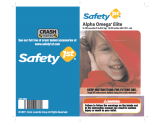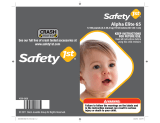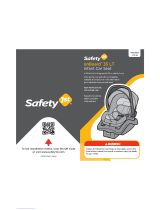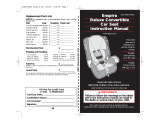
Knowing Your Vehicle Belts
30
Review your vehicle owner’s manual for vehicle seat belt use with
child restraints. This is your best source for information concerning
your vehicle.
Not all vehicle belts will work with this child restraint. This child
restraint must be tightly locked in place at all times. You must
determine if your vehicle’s belts are compatible with this child
restraint.
Vehicle Belts • Automatic/Passive vehicle seat belts
You MUST have a lap belt to install any child
restraint. An automatic (passive) shoulder belt
may or may not have a separate lap belt.
• Do not use with inflatable seat belts
You may need to move the child restraint to another seating loca-
tion or use LATCH belts only.
• Vehicle belts in center of the door or side panel
You must move the child restraint to another seating location.
• Vehicle belts that are in front of the seat
bight
You may need to move the child restraint to
another seating location.
• ELR (Emergency Locking Retractor) vehicle belts
These belts only lock in a sudden stop or crash, and do not prop-
erly secure a child restraint alone.
To determine if you have this type of belt,
gently pull the belt all the way out of the retractor
(spool), let it return several inches, then pull on
it again. If it moves freely, it is an ELR belt. If it is
locked and will not allow any more belt to come out, it is a switch-
able retractor.
If you have an ELR lap and shoulder belt, review the “Vehicle Latch
Plate” section on page 30 to see if you need a locking clip.
WARNING: ELR lap-only belts MUST NOT be used with
this child restraint.
29
• Switchable Retractor
These belts switch from ELR to ALR (Automatic Locking Retractor).
You MUST have the vehicle belts in the locking mode to use them.
With a switchable retractor, pull the shoulder belt all the way out to
switch the retractor into the ALR mode before tightening.
Feed the slack back into the retractor while tightening.
• ALR (Automatic Locking Retractor)
These belts lock after pulling the webbing out and letting the belt
go back into the retractor an inch or two.
With an ALR belt, pull the belt all the way out before threading
through the child restraint.
Vehicle Latch Plates
• Check Latch Plates Grasp the tongue portion of the
latch plate (the part that goes
inside the buckle) and pull straight
out, in line with the lap belt.
If the latch plate does not slide
up and down the vehicle belt, you
have a locking latch plate. You
should not need to use a locking
clip.
Check your vehicle owner’s manual to determine the best way to
lock a child restraint in place and whether the latch plate or retrac-
tor will accomplish this. If the latch plate slides up and down on
the belt, and you have an ELR retractor, you MUST use a locking
clip to install the child restraint. See pages 52-53.
You may not need to use the locking clip with a switchable or ALR
retractor.
Locking Latch
Plate
Sliding Latch
Plate
































